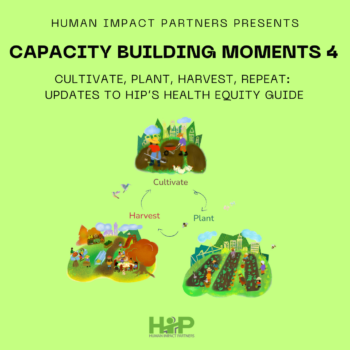| By Kim Gilhuly & Holly Avey |
When we started this evaluation of how the field of HIA is doing at encouraging community participation in HIA, we have to admit, we had low expectations. But the results are in, and they are much more encouraging then we thought they might be.
At HIP, we have focused on community participation as a key way to reach international HIA goals of democracy and equity. We strive in our work to authentically and intentionally encourage community members who are impacted by public decisions to be involved in the HIA process. But, to be honest, we didn’t know for sure if community participation would lead to greater democracy and equity, or how strong the connection would be. So we set out to study it.
How do you measure how much a community participated in an HIA? How do you measure how that participation impacted democracy and equity? We started by diving into the literature and looking for resources to help us figure that out. First, we found the International Association of Public Participation’s Spectrum of Participation, and we adapted it to be more specific to HIA.
Then, we had long discussions about what the ultimate outcome of democracy might be, on an individual and collective level, and we decided it was captured best by the concept of civic agency. We defined civic agency as: a community’s ability to organize and undertake collective action in its own self-interest. We measured civic agency by creating survey questions that lined up with the ways civic agency was discussed in the literature. We asked questions about community members taking action, increasing contact with decision makers, strengthening skills to influence future decisions, and if community voices about the HIA topic were heard.
Once we had our questions ready, we sent out our survey to HIA team members and to the community members that participated in their HIAs. We got nearly 100 respondents (63 HIA team members and 30 community members), representing 47 HIAs across the US. We followed this up with an in-depth study of four HIAs that we followed from beginning to end, to better understand the context of our findings and see if there was anything we missed.
Turns out, the field is doing a better job at incorporating community participation in HIAs than we thought. Most respondents reported that the level of community participation in their HIA fell in the middle of the spectrum, at the “involve” level. Perhaps even more encouraging, community members ranked their HIAs as higher in community participation than HIA practitioners did.
Figure 1. Level of Community Participation as reported by HIA team members (N = 59) and community members (N = 28).
Another finding that was stronger than we expected – no one feels like the community participation has a negative impact on the success of their HIA. In fact, a whopping 84% said they thought it had a positive impact.
Figure 2. Impact of Community Participation on the Success of the HIA
In fact, further analysis showed that HIAs that had higher levels of community participation had better odds of successfully impacting the HIA decision point (this is how we defined success). In other words – it’s not just having the community participate that improves the success of an HIA, it’s having the community participate at high levels of participation.
Finally, HIAs are doing a good job at supporting democracy through civic agency. With responses ranging from 63% to 85%, the majority of respondents reported that each measure of civic agency was achieved through the community participation in their HIA. This is great news. While we always suspected this would be the case – it makes intuitive sense that involving people more in the decision-making process that impacts their lives increases democracy – it is very encouraging to see this documented.
Figure 3. Civic agency outcomes (N = 88)
So overall, this study was able to contribute to the field of HIA by helping to define levels of community participation and impact on democracy through civic agency. We were able to show that the field of HIA is already doing a decent job of community participation in HIA, and community participation is contributing to civic agency and to the success of HIAs. Higher levels of participation led to even more successful HIAs.
But there’s still room for improvement. Less than one-third of the respondents indicated that community participation in their HIA was at one of the top two levels on the spectrum – where the most benefit comes. The findings from this study give us even more reason to keep striving for these higher levels of participation. We thought this was true, and now we know it is. Good news, indeed.
Check out our full report for more information on recommendations to enhance community participation in HIAs.








